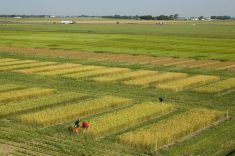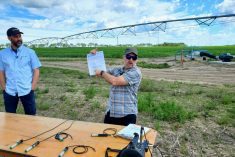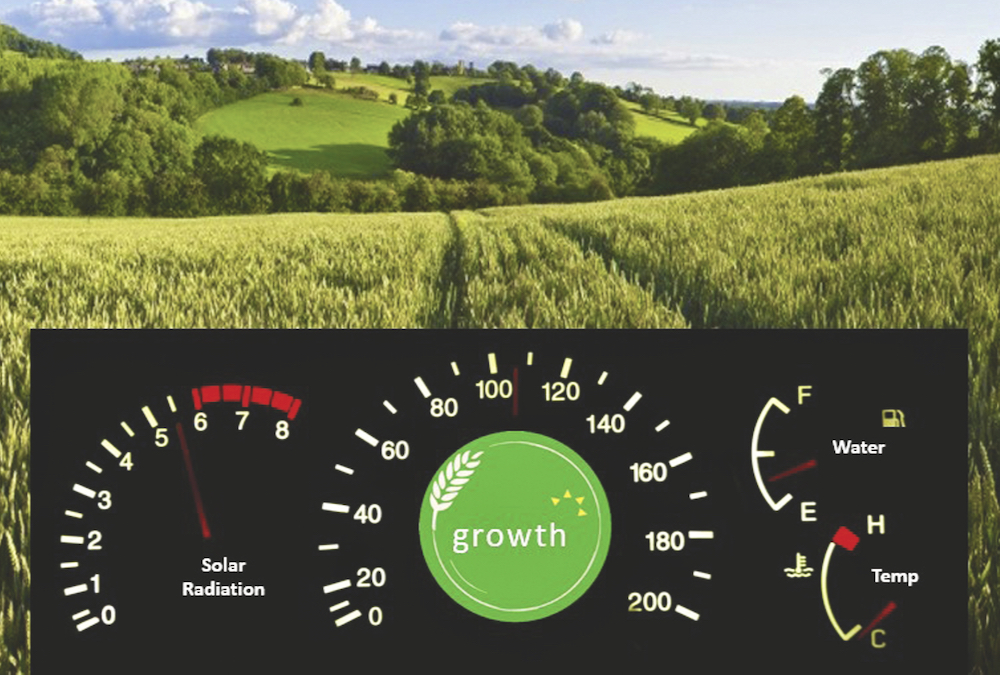Severe stripe rust infections in central Alberta have put wheat growers on high alert, says a federal research scientist.
“Because wheat is such an important crop, stripe rust is one of those diseases that could have a major, major impact on cereal crop production,” said Denis Gaudet of Agriculture and Agri-Food Canada.
“To me, it represents one of the most serious pathogens and potential threats to crop production anywhere in the world.”
In early June, researchers found “heavy infections of stripe rust” in winter wheat fields near Olds, a result of overwintering of the disease in the crop.
Read Also

Physiological leaf spot suspected in southern Alberta winter wheat
Physiological leaf spot has been suspected in winter wheat fields in southern Alberta. It is important for farmers to be scouting for PLS during June and July to asses the risk to their crops.
“The conditions there are pretty good for the winter survival,” said Gaudet. “They generally get a nice blanket of snow that’s continuous. That helps preserve the leaf tissue and the fungus in those leaf tissues throughout the winter.”
The disease was also found in “a few plants” near the Lethbridge research centre in mid-June, but overwintering doesn’t seem to be the culprit there.
“We’re convinced that it came in on a spore shower from the Pacific northwestern United States (in late May),” he said.
- More from the Alberta Farmer Express: Stripe rust on winter wheat being reported near Olds, Alta.
Most years, the spores arrive too late to cause damage.
“We caution farmers to be very careful when they consider applying fungicides. They need to really look at the crop stage that they’re at and whether or not they’re seeing a lot of stripe rust.”
Normally, stripe rust presents as long pustule stripes on leaves that, as they erupt, cause the leaves to shrivel. The disease causes the most problems in the upper leaves — the flag leaf and flag minus one — because those leaves are “most closely associated with yield and quality in wheat.”
“If there’s very little rust on them going into flowering, we don’t necessarily recommend spraying,” Gaudet said.
“But if… by the time it is flowering, we’re starting to see rust on the lower leaves and moving up, we want to make sure we protect those upper leaves through the flowering and maturation process.”
Resistance breakdown
Stripe rust became a problem in southern Alberta more than seven years ago, when the disease began to mutate and overcome the resistance in some varieties of winter wheat.
“There was a major shift in pathogenicity at the time, and all of a sudden, we had a whole bunch of winter wheat that was highly susceptible to this new race of stripe rust,” said Gaudet.
The disease has “a tremendous capacity to evolve,” a result of its ability to build up “rapidly and dramatically.”
“We’re quite concerned about it,” he said. “In addition to our winter wheat being susceptible, many of our spring wheat varieties are susceptible as well. Producers have to be very careful now which varieties they choose.”
In North America, plant breeders have been selecting a more generalized form of resistance that the pathogens are less able to adapt to, but that comes with some limitations.
“These types of resistances aren’t as effective and are more prone to environmental modulations,” Gaudet said.
“If it’s cool and wet for an extended period of time, the resistance may not be as effective.”
Even so, varieties that contain more than one form of resistance will be “a lot more durable in the field over time” when compared with resistance that is race specific. Because of that, producers should only seed resistant varieties, he said.
“There is the option to select your control measure before you actually go into the field,” said Gaudet. “On the spring wheat side, there are varieties that have good resistance. On the winter wheat side, there are varieties that only suffer minor damage from stripe rust.”
For producers who have already seeded susceptible varieties, “step No. 2 is to get out and monitor your fields to check for the presence of stripe rust.”
“We’re advising producers not to panic right now or consider any control measures in their winter wheat,” said Gaudet, adding researchers with both the provincial and federal governments are monitoring the disease situation “very closely.”















